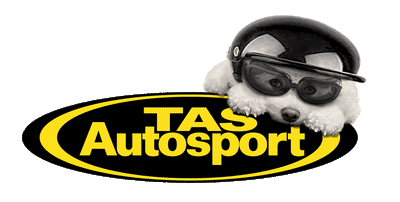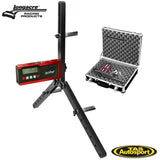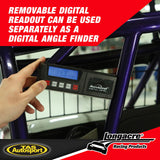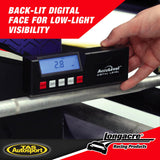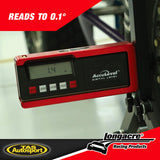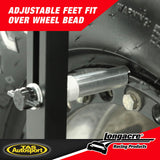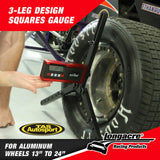
Here's a super accurate digital caster / camber gauge that reads to .1º (1/10º) camber and to .1º caster as high as needed, and at a price any serious team can easily justify. It comes with our QuickSet™ Large Wheel adapter and a hard case. As an additional benefit the AccuLevel™ digital readout can be removed and used separately as a digital angle finder for suspension, spoiler angles, and many other things.
Includes:
- Digital Caster/Camber Gauge
- AccuLevel™ Pro Model with back light (removable)
- QuickSet™ Large Wheel adapter
- Hard case
QuickSet™ Large Wheel Adapter
This is the fastest way to check your front end alignment. Just hold it against the rim for easy, accurate readings. No spindle adapters required here. Billet aluminum fully CNC machined. Rigid for accurate readings. Three-leg design squares gauge to your wheel.
Works on most any race car, 13" to 24" aluminum , 'feet' adapt to wheel bead. 3 point design makes setting caster easier. Folds for easy storage.
Specifications Caster Camber Gauge
Housing Material:Billet Aluminum
Finish:Red anodized
Camber Increments:.1°
Positive Camber Adjustments:0 to +90°
Negative Camber Adjustments:0 to -90°
Caster Increments:.1°
Positive Caster Adjustments:0 to +90°
Negative Caster Adjustments:0 to -90°
Backlit Display:Yes
Bubble Level Included:Yes
Adapter Included:Yes
AccuLevel™ Removable:Yes
Case Included:Yes
Bolt Size:5/16"-18
Adapter
Style:Dunlop™ style
Wheel Range:13" - 24"
Material:Billet Aluminum
Finish:Black anodized
Camber Simplified
Camber is the tilt of the tire as viewed from the front of the car. If the top of the tires lean toward the center of the car then you have negative camber. If the top of the tire tilts out away from the center of the car then you have positive camber.
Adjusting camber can have a dramatic effect on the cornering of your car. Most oval track racers run negative camber on the right side of the car and positive camber on the left. Optimum camber settings will result in more speed and ideal tire wear.
Camber is measured with a caster camber gauge and is usually easily adjusted with shims or adjustable upper a-arms. Always check the toe when making camber or caster adjustments.
The amount of static camber that you should run is a result of testing, pyrometer measurements, front suspension geometry and discussions with your car builder. Remember that poor camber settings will cause excessive tire wear. Camber settings set to extremes can reduce the braking ability of the car.
Caster Simplified
To understand caster you need to picture an imaginary line that runs from through the upper ball joint and extends through the lower ball joint. From the side view the imaginary line will tilt forward or backward. The tilting of this imaginary line is defined as caster.
Caster is measured in degrees by using a caster camber gauge. If the imaginary line described above tilts towards the back of the car, at the top, then you will have positive caster. If the imaginary line tilts forward then you would have negative caster.
Positive caster provides the directional stability in your racecar. Too much positive caster will make the steering effort difficult. Power steering will allow you to run more positive caster. Negative caster requires less steering effort but can cause the car to wander down the straightaway.
For oval track racing most racers run more positive caster on the right side tire than on the left. The caster split helps pull the car down into the turn, helps the car turn in the center and helps it stay hooked up on exit.
How much caster should you run? The amount and split depends on the type of car and track conditions. The details should be worked out with your car builder and through testing.
